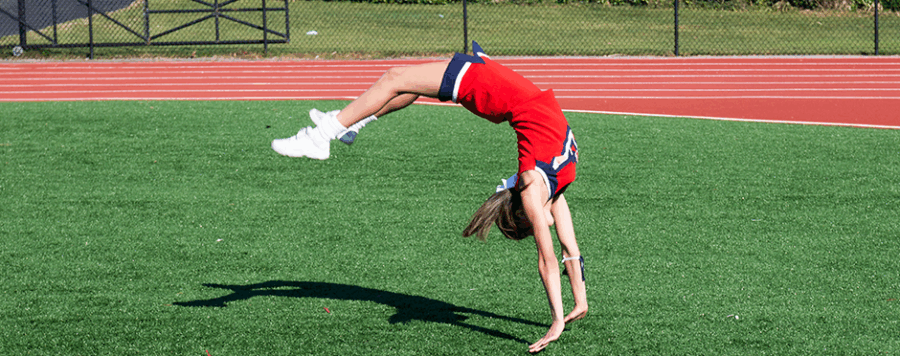What Do You Mean A “Broken Back”?
The medical terms for a broken back are Spondylolysis and Spondylolisthesis.
Spondylolysis involves a stress fracture of the vertebrae that connects the body of the vertebrae to the spinous portion, the part that sticks out along your back. These types of fractures can be found on one side only or on both sides of the vertebrae.
Spondylolisthesis is a progression of spondylolysis where a fracture is found on both sides (right and left), and the vertebrae slips forward over one another, which can cause damage to other spinal structures.
Who Is At Risk?
The cause of spondylolysis is generally associated with hyperextension-type activities such as tumbling or repetitively bending backward. These activities are found in sports, including gymnastics, dance, and cheerleading. Younger athletes may be more at risk for hyperextension injuries due to overuse and increased hours spent practicing.
Symptoms Of Spondylolysis Or Spondylolisthesis:
- Pain in the lower back
- Back stiffness
- Difficulty walking or standing for long periods
- Pain with bending over
- Numbness, weakness, or tingling in the foot is possible
- Muscle spasms in the back, gluteal muscles, or hamstrings
Treatment Options:
Most often, spondylolysis’s main symptom is lower back pain. Imaging is used to diagnose the issue and whether the injury is spondylolysis or spondylolisthesis. Treatment for both focuses on managing the pain symptoms. Most treatments include:
- Rest from sports
- Anti-inflammatory medications and use of ice
- Physical therapy for muscle strengthening
- Possibly a lumbar brace
- Surgical options are available if other treatments do not work
Returning To Tumbling After A Back Injury
After four to six weeks of rest, not participating in sports, and participating in physical therapy treatment and other appropriate medical treatment, many athletes can start a jogging program and progress to running. They must remain pain-free when running to begin to resume more sport-type activities. Tumbling athletes should progress slowly for backward extension type activities such as back walkovers or back handsprings.
Prevention
We know certain risk factors can contribute to the chance of having low back pain in these types of injuries. These include:
- Core abdominal weakness
- Tightness in hip extension and shoulder flexion
- Tightness in the thoracolumbar fascia
- Hyperextension in the knees
- Increased thoracic kyphosis
- Repetitive extension movements
With these factors in mind, we can attempt to prevent low back injury by focusing on:
- Proper body mechanics: We want to make sure athletes are stretching on both the right and left sides. They should be fairly equal, even if they have a dominant leg for tumbling or leaping.
- When performing a bridge, the athlete should not excessively hinge in the lower back but be able to hinge through the entire spine and shoulders like a rainbow.
- Proper landing mechanics: athletes should not land in a hyperextended low back position; they should be able to absorb the force of the landing while maintaining a neutral spine
- Athletes should perform regular exercises for abdominal muscles and back muscles for strengthening and stability.
- Eat a well-balanced diet to help with good bone health.
- Limit repetitions, especially in younger and growing athletes; pay attention to the training schedule and allow for rest.
- Athletes should discuss any injuries with their coaches and parents so they can address them promptly.
A Team Approach
Although a broken back sounds scary and should be taken seriously, tumbling athletes can return to their sport after injury. With a team approach between the athlete, coaches, parents, and a physical therapist, a broken back can heal, and you can return to the sport you love. Find a licensed physical therapist near you today who specializes in gymnastics and cheerleading rehabilitation to help you, or your athlete get back to doing what they love pain-free!
Find a Gymnastics/Cheerleading Specialist Near You
*Per federal guidelines, beneficiaries of plans such as Medicare, Medicaid, Tricare, VHA and other federally funded plans are not eligible for free assessments.
The Athletico blog is an educational resource written by Athletico employees. Athletico bloggers are licensed professionals who abide by the code of ethics outlined by their respective professional associations. The content published in blog posts represents the opinion of the individual author based on their expertise and experience. The content provided in this blog is for informational purposes only, does not constitute medical advice and should not be relied on for making personal health decisions.
References:
1. Anand Prakash A. Return to play after spondylolysis: An overview. Med J Armed Forces India. 2021 Jan;77(1):6-14. doi: 10.1016/j.mjafi.2020.11.011. Epub 2020 Dec 23. PMID: 33487859; PMCID: PMC7809564.
2. Iwamoto J, Sato Y, Takeda T, Matsumoto H. Return to sports activity by athletes after treatment of spondylolysis. World J Orthop. 2010 Nov 18;1(1):26-30. doi: 10.5312/wjo.v1.i1.26. Retraction in: World J Orthop. 2018 Mar 18;9(3):58-59. PMID: 22474624; PMCID: PMC3302027.
About the Author:
Tara Hackney, a physical therapist in Marion, IA, enjoys working with all patient types, especially gymnasts, cheerleaders, and dancers. She is the prominent blogger for Athletico's Gymnastic/Cheer Program. With an orthopedic specialization and training in dry needling and Graston technique, Tara hopes to answer your questions about injuries and injury prevention in an easy-to-understand manner. She hopes to ease fears surrounding pain and injuries, address concerns about recovery, and provide tips to prevent injury. In her free time, she enjoys spending time with her dog, reading, and watching her nephews play sports.

 width="900"
height="356"
>
width="900"
height="356"
>
